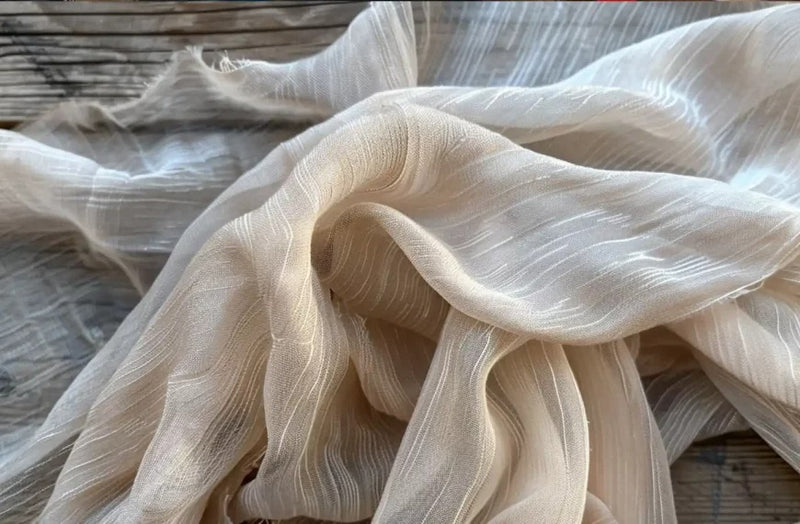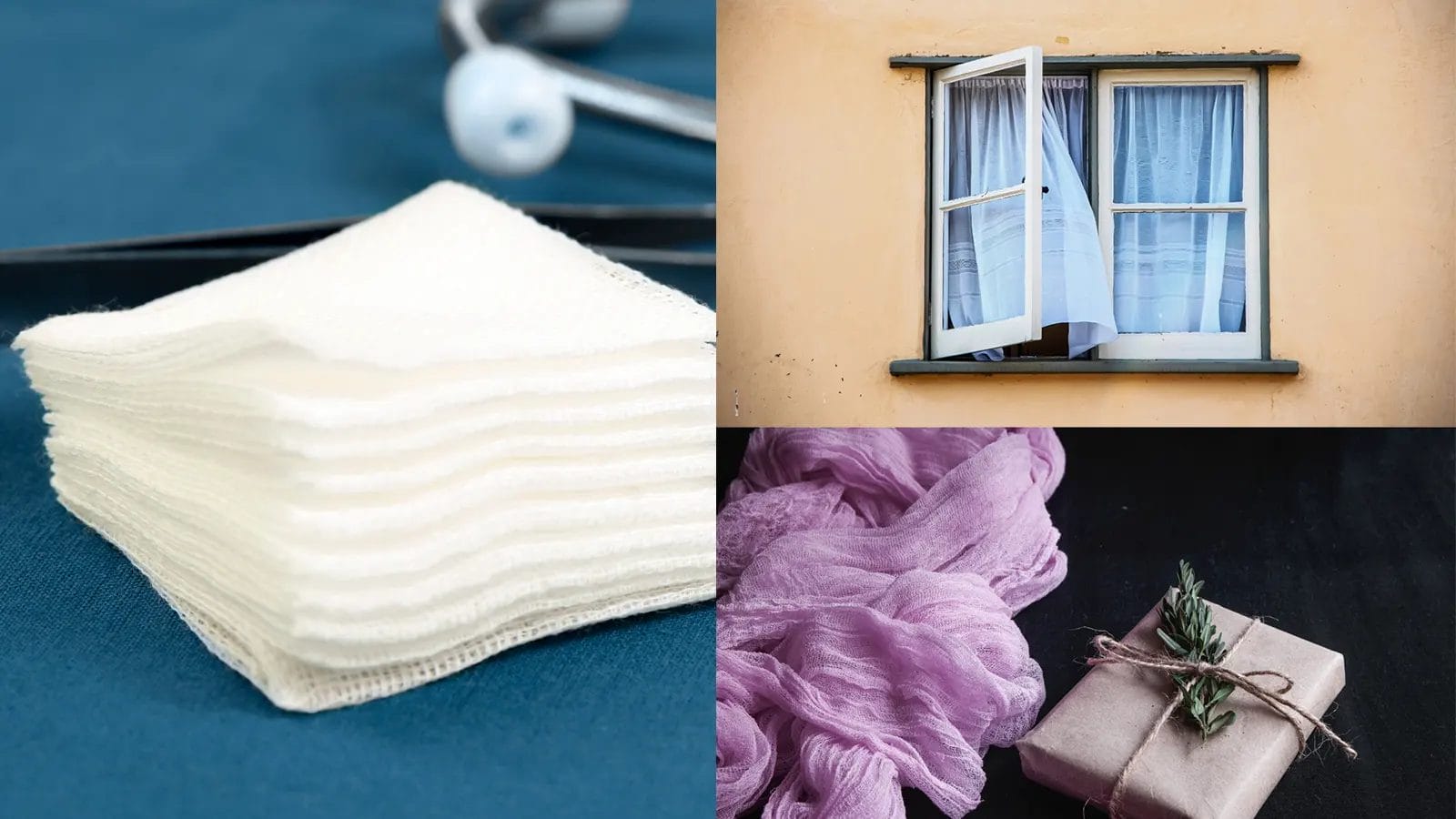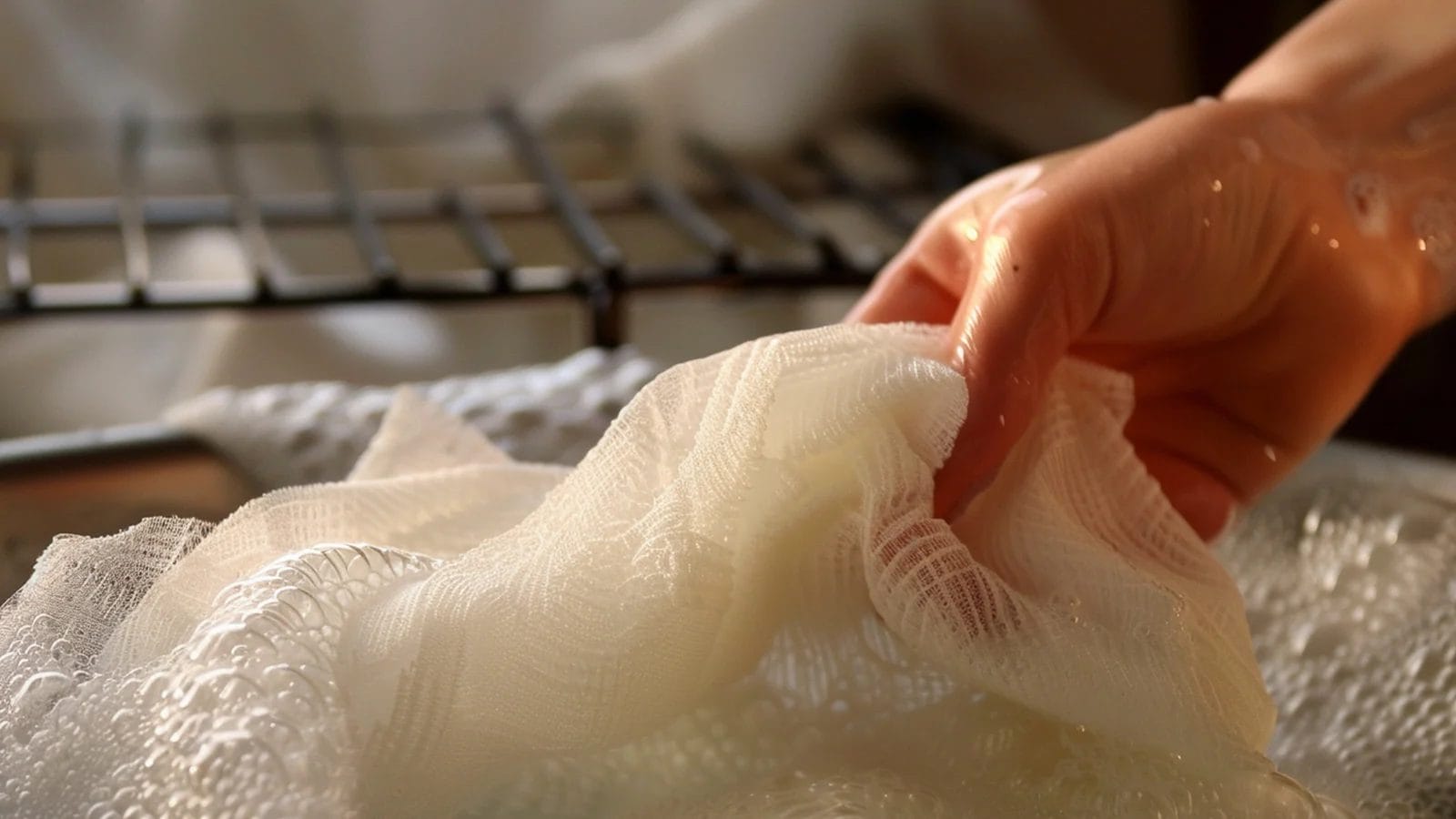
Gauze fabric is a lightweight, breathable material known for its moisture-absorption properties. Its open-weave structure facilitates excellent air circulation. It is versatile for use in various sewing projects. It is meticulously manufactured, from the selection of yarn to strict control of finishing processes. Notably, the fabric's used extensively in medical settings for dressings, due to its incredible air circulation and absorbency. You might also notice it in the clothes you wear, specifically summer apparel, given its airy qualities. Caring for gauze requires specific techniques. So stay tuned to learn more about enhancing its lifespan.
Key Takeaways
- Gauze fabric is a lightweight and breathable material. It is known for its open weave structure allowing excellent air circulation.
- It is manufactured through processes like yarn preparation, weaving on a Leno loom, bleaching, and finishing for quality and durability.
- Gauze fabric is extensively used in the medical field for dressings due to its moisture absorption properties and breathability.
- Gauze fabric is popular in fashion and home decoration. It is perfect for children's clothing and window treatments.
- To care for gauze fabric, add vinegar when washing, dry it flat, and avoid ironing to maintain its texture and durability.
What is Gauze Fabric?
 Gauze fabric is a thin, lightweight, and semi-transparent material with an open weave design that makes it breathable. Often made from cotton, gauze exhibits an airy mesh effect. This property makes it a favorite for summer clothing. This fabric can let the skin breathe, reducing heat retention.
Gauze fabric is a thin, lightweight, and semi-transparent material with an open weave design that makes it breathable. Often made from cotton, gauze exhibits an airy mesh effect. This property makes it a favorite for summer clothing. This fabric can let the skin breathe, reducing heat retention.
Its breathability and absorbency also find use in medical settings, including bandages and dressings. The fabric is light and drapes well, giving garments a casual and natural appearance. It is also slightly transparent, making window treatments feel airy.
Manufacturing Process of Gauze Fabric
You'll want to consider the manufacturing process of gauze fabric, beginning with the preparation of the yarn. Understand the way in which weaving on a loom produces the distinctive mesh effect characteristic of the fabric. Note the bleaching and finishing steps that improve the color, texture, and quality of the gauze fabric.
Preparation of Yarn
In the manufacturing of gauze fabric, the first step is preparing the yarn. This step is crucial because it determines the final quality and durability of the fabric. To make gauze, we need to choose yarns with specific qualities. We want the gauze to be breathable, absorbent, and strong.
The yarns undergo a meticulous preparation process to ensure consistency. It is essential for the weaving process that follows. This stage isn't merely about preparing yarns for weaving, but also about enhancing their inherent strength.
The quality of your gauze fabric is, in many ways, a reflection of the quality of the yarn preparation. Without the right groundwork in yarn preparation, the final fabric might compromise on its strength and durability.
Weaving Process
After the yarn is prepared, the loom weaves it into the unique open mesh of gauze fabric. This weave, unique to this loom, creates an open mesh effect, allowing for the fabric's signature breathability.
Bleaching Process
Bleaching is an important step in manufacturing gauze fabric. It improves the appearance and texture by making it uniform, clean, and bright. This makes it suitable for many different uses.
The fabric undergoes bleaching to improve its color consistency and brightness. This crucial step helps achieve a uniform appearance and enhances the overall texture and visual appeal of the fabric.
It's not just about aesthetics, though. Bleaching cleans and brightens fabric for various uses, such as summer clothing and baby products. Without this important process, gauze fabric wouldn't meet quality standards. And it reduces its usefulness in fashion and other practical purposes.
Finishing Touches
After weaving, the gauze fabric goes through a careful finishing process to improve its texture and appearance. Texture enhancement is achieved through precise mechanical and chemical treatments. It adds the final touches to the fabric's feel.
This rigorous finishing process gives gauze fabric its characteristic soft, crinkled texture and light, airy feel. As a result, you get a high-quality, versatile material ready for various applications.
Characteristics of Gauze Fabric
You'll find gauze fabric to be remarkably lightweight and breathable, ideal for those hot summer days when comfort is key. It's also highly absorbent, so it's a go-to for products that need to soak up moisture efficiently. Plus, it's an easy material to sew, making it a popular choice for both fashion and practical applications.
Lightweight
Gauze fabric is lightweight, making it suitable for hot weather clothing. This lightweight quality is what makes gauze so comfortable to wear, providing an airy feel that's perfect for summer.
This fabric, with its open, plain weave structure, isn't just practical but also stylish. It has a unique ribbed surface that adds visual interest to any garment. Gauze also showcases a beautiful drape, a result of its slight horizontal stretch and light to medium weight.
This attribute enables clothing to move gracefully. It makes it a popular choice for creating chic, comfortable pieces.
Breathability
It's the breathability that truly sets it apart, especially in warmer climates.
Gauze fabric is breathable and perfect for hot weather because of its open weave structure. This breathability reduces heat retention, keeping your skin cool and comfortable.
The lightweight nature of the fabric enhances this effect. So it is an excellent choice for loose, breezy summer clothing. Gauze fabric is great for both casual beach cover-ups and elegant summer dresses because it offers a unique mix of style and comfort.
Moisture Absorption
Beyond its breathability, gauze fabric excels in moisture absorption, a crucial characteristic that enhances comfort for the wearer. It's this absorbent nature that makes it an ideal material for summer clothing.
The fabric's open weave helps absorb moisture from the skin, keeping you dry and comfortable in hot weather. This same feature also ensures quick evaporation, so your clothes don't stay damp.
Gauze is commonly used in towels, bandages, and baby products because it can absorb a lot of moisture.
Easy to Sew
Gauze fabric is great for summer wear and baby products because it's absorbent. Also, it's easy to sew, which makes it stand out in the textile industry.
As a lightweight and airy fabric, gauze is simple to sew with, whether you're a novice or a seasoned professional. The open, plain weave style of gauze allows for effortless needle penetration. Its slight horizontal stretch and soft texture make the fabric forgiving during the sewing process, accommodating any minor errors.
Usages of Gauze Cotton Fabric
 You'll find gauze cotton fabric in a variety of applications due to its unique properties. It's used extensively in the medical field for dressings, but its versatility doesn't stop there.
You'll find gauze cotton fabric in a variety of applications due to its unique properties. It's used extensively in the medical field for dressings, but its versatility doesn't stop there.
You'll also see it in fashion and clothing, and even home decoration, demonstrating its broad utility and appeal.
Medical Application
Gauze cotton fabric plays a crucial role in the field of medicine. Because it helps wounds heal by allowing air to circulate and providing a soft, absorbent dressing. Its open weave allows it to breathe, creating a comfortable environment for healing wounds.
You'll see this fabric in use extensively due to its affordability and infection prevention properties. Its absorbency is key, drawing out and locking in moisture, critical for wound healing.
Fashion and Clothes
Gauze cotton fabric is popular in fashion because it's lightweight, breathable, and soft. This versatile material is a go-to choice for designers crafting airy summer apparel. Gauze fabric is ideal for making baby's clothes.
Its inherent breathability makes it ideal for dresses, blouses, and skirts. It lessens heat retention and maximizing comfort during warm seasons. You'll also find it in accessories, proving its adaptability in the fashion industry.
Home Decoration
Gauze cotton fabric is also used in home decoration, especially for window treatments, curtains, and bed linens. Its semi-transparency is a key attribute. It allows light to subtly filter through, providing a soft, natural illumination while maintaining privacy.
Gauze's breathability enhances your home decor, promoting a sense of airiness and openness in any room. This fabric is great for making comfortable and lightweight bed linens.
Gauze cotton fabric is essential for home decoration, as it adds elegance and comfort, whether you prefer a minimalist or rustic style.
Tips for Caring for Gauze Fabric
 To preserve the color and texture of gauze fabric, add vinegar when washing for the first time. After washing, it's best to dry the fabric flat to prevent deformation or stretching. Lastly, if you're looking to remove wrinkles, try to avoid ironing and opt for light steaming or freshening sprays instead.
To preserve the color and texture of gauze fabric, add vinegar when washing for the first time. After washing, it's best to dry the fabric flat to prevent deformation or stretching. Lastly, if you're looking to remove wrinkles, try to avoid ironing and opt for light steaming or freshening sprays instead.
Add Vinegar to Set the Color When Washing Gauze Fabric
Adding vinegar to the washing process helps maintain the vibrant color of gauze fabric because it acts as a natural fixative. This industry-specific method prevents the color from fading, ensuring the fabric retains its original hue. This is especially significant for gauze garments where color integrity is key.
Vinegar's acidic properties bond with the fiber, setting the color and enhancing its longevity. It's a simple, yet effective trick to keep your gauze fabric looking fresh and vibrant. As a natural fixative, vinegar doesn't just set the color but also contributes to overall fabric care. So, when washing your gauze fabric next, don't forget to add a splash of vinegar to the cycle.
Place the Fabric on a Flat Surface to Dry
It's equally important to focus on the drying process. To prevent stretching or misshaping, lay the fabric flat to dry. This technique maintains the fabric's original structure and size. If possible, place the fabric in direct sunlight. This not only hastens the drying process but also naturally freshens and sanitizes the fabric.
Always ensure the fabric is completely dry before storing it. Moisture can lead to mildew or unpleasant odors. Proper drying techniques like these can extend the lifespan of your gauze fabric, keeping it looking fresh and new.
Avoid Ironing Gauze Fabrics If Possible
To keep cotton gauze fabric's unique texture, avoid ironing because it can damage the material and change its natural, crinkled look. You may be tempted to smooth out the creases, but resist this urge. Ironing not only risks damaging the fabric but also flattens its inherent texture, taking away its unique appeal. Instead, I suggest air-drying your gauze items. This method of care will help preserve the fabric's shape and size while maintaining its delicate nature.
Conclusion
So, you've entered the world of gauze fabric. Its unique manufacturing process results in an airy, absorbent material perfect for beating the heat.
Whether you're crafting chic summer outfits or practical baby products, gauze has got you covered. But remember, this fabric needs gentle care to maintain its integrity.
Discover the extraordinary versatility of gauze fabric. Let it transform your wardrobe, your craft projects and even your comfort level on those hot summer days.
Learn more about fabric knowledge at Longan Craft Blog, and dive into the fabric world with Longancraft!

0 comments